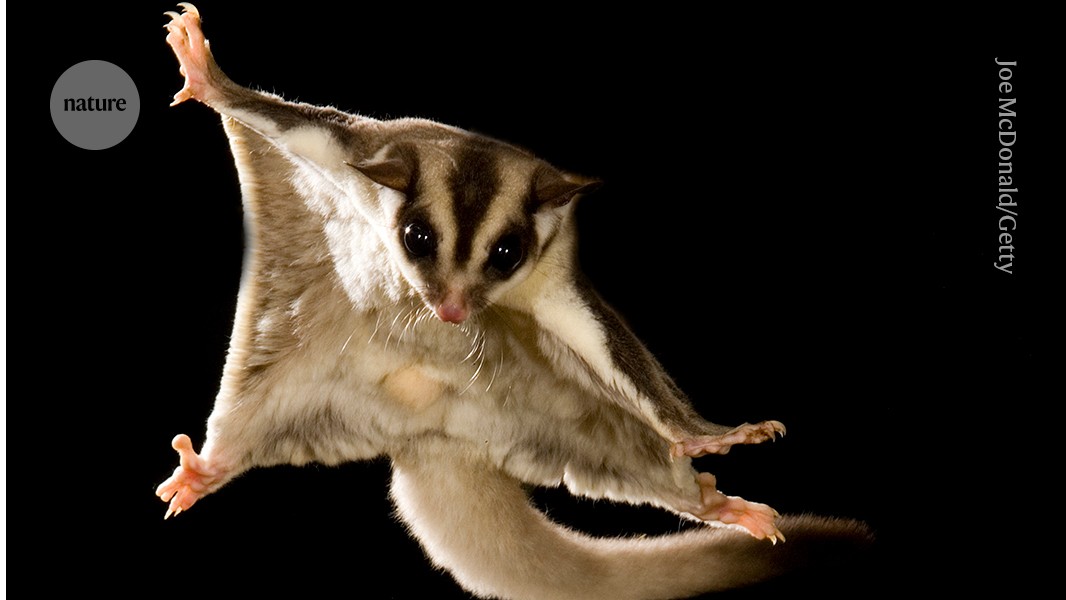Molecular Insights into the Evolution of Gliding Membranes in Marsupial Species
Core Concepts
Marsupial species have evolved a highly elastic and resistant skin membrane, known as the patagium, which enables them to glide through the air, providing advantages in foraging and predator avoidance.
Abstract
The content discusses the evolutionary adaptation of a specialized skin membrane, called the patagium, in certain marsupial species that allows them to glide through the air. The patagium extends from the forefeet to the hindfeet, enabling the marsupials to glide for up to 50 meters after jumping from a tree. This adaptation provides several advantages, such as the ability to search for food over wider areas with less energy expenditure and the ability to quickly escape from predators and aggressive tree-climbers.
The article highlights that a recent study by Moreno et al. in Nature has shed light on the elusive molecular mechanisms that allowed this evolutionary adaptation to emerge in marsupials. The patagium is a highly elastic and resistant skin membrane, similar to the webbed-sleeved jumpsuit used by wingsuit skydivers, which was inspired by these natural membranes. The content suggests that understanding the molecular basis of this adaptation in marsupials can provide insights into the evolution of self-powered flight in other species, such as bats and now-extinct pterosaurs.
Marsupial genomes reveal how a skin membrane for gliding evolved
Stats
Marsupial gliders can glide for up to 50 metres after jumping from a tree.
Quotes
"After jumping from a tree, a marsupial glider will rely on its patagium to glide for up to 50 metres, maneuvering gracefully through the air with only tiny movements of its limbs."
Key Insights Distilled From
by Darí... at www.nature.com 04-24-2024
https://www.nature.com/articles/d41586-024-01021-8
Deeper Inquiries
How do the molecular mechanisms underlying the evolution of the patagium in marsupials compare to the mechanisms responsible for the development of wings in bats and pterosaurs?
The molecular mechanisms underlying the evolution of the patagium in marsupials, as revealed by Moreno et al., shed light on the genetic changes that facilitated the emergence of this unique adaptation. While the patagium in marsupials serves as a gliding parachute, enabling them to glide through the air with precision and efficiency, the development of wings in bats and pterosaurs allowed for self-powered flight. The genetic pathways involved in the formation of the patagium in marsupials likely involve the regulation of genes responsible for skin elasticity, resistance, and the formation of the membrane structure. In contrast, the evolution of wings in bats and pterosaurs would have required the activation of genes related to muscle development, bone structure modification, and aerodynamic adaptations. Despite these differences, there may be some shared genetic elements related to the development of appendages for aerial locomotion across these diverse species.
What are the potential trade-offs or constraints that may have influenced the evolution of the patagium in marsupials, and how do these compare to the factors shaping the evolution of other gliding or flying adaptations in nature?
The evolution of the patagium in marsupials likely involved various trade-offs and constraints that influenced its development. One potential trade-off could be the allocation of resources towards the growth and maintenance of the patagium, which may have come at the expense of other physiological functions or adaptations. Constraints such as environmental factors, predator-prey dynamics, and competition for resources could have also played a role in shaping the evolution of the patagium. Comparatively, other gliding or flying adaptations in nature, such as the wings of birds or insects, may face different trade-offs and constraints. For instance, the energy expenditure required for sustained flight may be a significant constraint for species with powered flight, influencing their foraging behavior, reproductive success, and overall survival strategies. Understanding these trade-offs and constraints is crucial for elucidating the evolutionary pathways of different aerial adaptations in nature.
Given the advantages provided by the patagium, what other ecological or behavioral adaptations might be associated with the evolution of this trait in marsupial species, and how could these insights inform our understanding of broader patterns of evolutionary change?
The evolution of the patagium in marsupial species likely led to the development of additional ecological and behavioral adaptations that complemented this unique trait. For example, marsupials with a well-developed patagium may exhibit specialized behaviors related to gliding, such as efficient foraging strategies that capitalize on their aerial mobility to access dispersed food sources. Ecologically, the presence of the patagium could influence habitat selection, predator avoidance tactics, and social interactions within marsupial populations. These insights into the interconnected nature of morphological, ecological, and behavioral adaptations in marsupials can inform our understanding of broader patterns of evolutionary change. By studying the coevolution of traits like the patagium with other aspects of marsupial biology, we can gain a more comprehensive view of how natural selection shapes the diversity of life forms on Earth.
0
